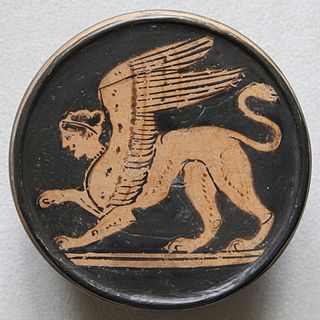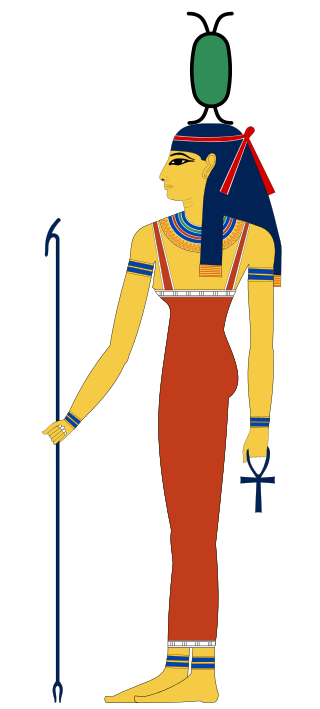
A solar deity or sun deity is a deity who represents the Sun or an aspect thereof. Such deities are usually associated with power and strength. Solar deities and Sun worship can be found throughout most of recorded history in various forms. The Sun is sometimes referred to by its Latin name Sol or by its Greek name Helios. The English word sun derives from Proto-Germanic *sunnǭ.

Set is a god of deserts, storms, disorder, violence, and foreigners in ancient Egyptian religion. In Ancient Greek, the god's name is given as Sēth. Set had a positive role where he accompanied Ra on his barque to repel Apep (Apophis), the serpent of Chaos. Set had a vital role as a reconciled combatant. He was lord of the Red Land (desert), where he was the balance to Horus' role as lord of the Black Land.

A sphinx is a mythical creature with the head of a human, the body of a lion, and the wings of an eagle.

Nut, also known by various other transcriptions, is the goddess of the sky, stars, cosmos, mothers, astronomy, and the universe in the ancient Egyptian religion. She was seen as a star-covered nude woman arching over the Earth, or as a cow. She was depicted wearing the water-pot sign (nw) that identifies her.
Tefnut is a deity in Ancient Egyptian religion, the feminine counterpart of the air god Shu. Her mythological function is less clear than that of Shu, but Egyptologists have suggested she is connected with moisture, based on a passage in the Pyramid Texts in which she produces water, and on parallelism with Shu's connection with dry air. She was also one of the goddesses who could function as the fiery Eye of Ra.

In Egyptian mythology, Sekhmet is a warrior goddess as well as goddess of medicine.

Nehebkau was the primordial snake god in ancient Egyptian mythology. Although originally considered an evil spirit, he later functions as a funerary god associated with the afterlife. As one of the forty-two assessors of Ma’at, Nehebkau was believed to judge the deceased after death and provide their souls with ka – the part of the soul that distinguished the living from the dead.

Neith was an ancient Egyptian deity, possibly of Libyan origin. She was connected with warfare, as indicated by her emblem of two crossed bows, and with motherhood, as shown by texts that call her the mother of particular deities, such as the sun god Ra and the crocodile god Sobek. As a mother goddess, she was sometimes said to be the creator of the world. She also had a presence in funerary religion, and this aspect of her character grew over time: she became one of the four goddesses who protected the coffin and internal organs of the deceased.

Babi, also Baba, in ancient Egyptian religion, was the deification of the hamadryas baboon, one of the animals present in ancient Egypt. His name is usually translated as "bull of the baboons", roughly meaning "chief of the baboons".
Psamtik III, known by the Graeco-Romans as Psammetichus or Psammeticus, or Psammenitus, was the last Pharaoh of the Twenty-sixth Dynasty of Egypt from 526 BC to 525 BC. Most of what is known about his reign and life was documented by the Greek historian Herodotus in the 5th century BC. Herodotus states that Psamtik had ruled Egypt for only six months before he was confronted by a Persian invasion of his country led by King Cambyses II of Persia. Psamtik was subsequently defeated at the Battle of Pelusium, and fled to Memphis where he was captured. The deposed pharaoh was carried off to Susa in chains, and later committed suicide.

Egyptian mythology is the collection of myths from ancient Egypt, which describe the actions of the Egyptian gods as a means of understanding the world around them. The beliefs that these myths express are an important part of ancient Egyptian religion. Myths appear frequently in Egyptian writings and art, particularly in short stories and in religious material such as hymns, ritual texts, funerary texts, and temple decoration. These sources rarely contain a complete account of a myth and often describe only brief fragments.
The worship of heavenly bodies is the veneration of stars, the planets, or other astronomical objects as deities, or the association of deities with heavenly bodies. In anthropological literature these systems of practice may be referred to as astral cults.
Perneb is the name of an ancient Egyptian prince and priest, who lived at the beginning of the 2nd Dynasty.

A lunar deity or moon deity is a deity who represents the Moon, or an aspect of it. These deities can have a variety of functions and traditions depending upon the culture, but they are often related. Lunar deities and Moon worship can be found throughout most of recorded history in various forms.
Western Egyptian Bedawi Arabic, also known as Sahil Maryut Bedouin Arabic, is a group of Bedouin Arabic dialects spoken in Western Egypt along the Mediterranean coast, west to the Egypt–Libya border. Ethnologue and Glottolog classify Western Egyptian Bedawi Arabic as a Libyan Arabic dialect.

Shesmetet(šsm.t.t) is an ancient Egyptian goddess. She was mentioned in the Pyramid Texts and was usually referred to as the deceased's mother. She was depicted as a lion or a woman with a lion's head, and thus was sometimes considered a form of Sekhmet or Bastet, but one of her epithets – "Lady of Punt" – differentiates her from them and may refer to a possible African origin. Her name comes from shesmet, a sash decorated with beads, which appears on the depictions of Old Kingdom rulers and the god Sopdu.
Saft el-Hinna, also written as Saft el-Hinneh, Saft el-Henna, Saft el-Henneh, is a village and an archaeological site in Egypt. It is located in the modern Al Sharqia Governorate, in the Nile Delta, about 7 km southeast of Zagazig.











